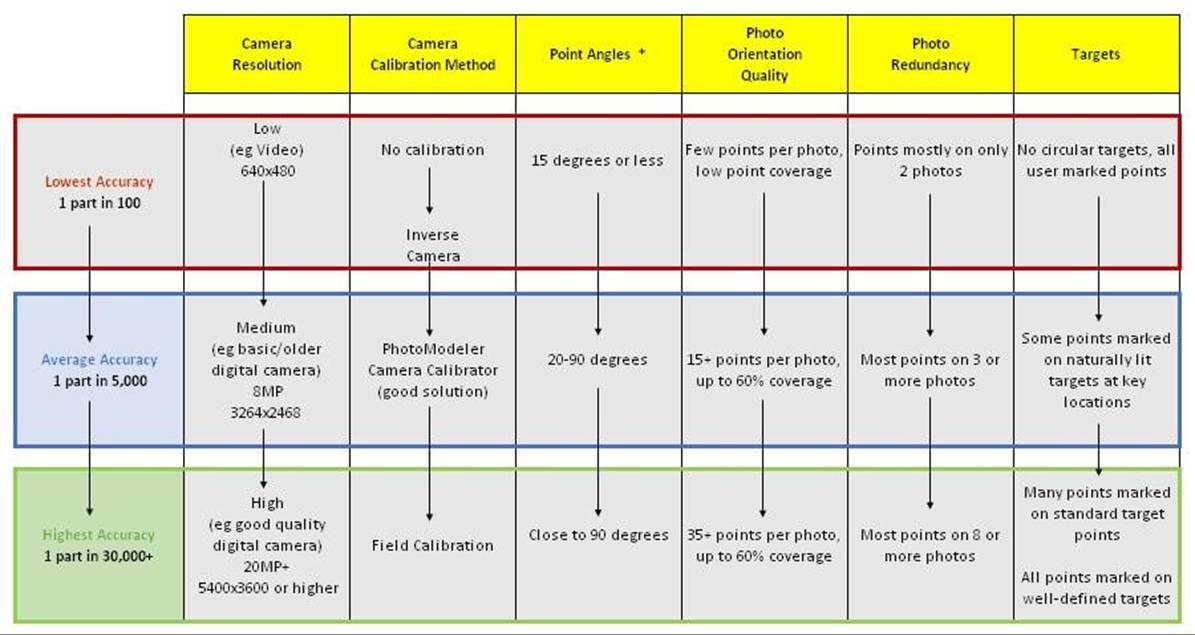

There are a number of factors involved in determining the accuracy in photogrammetry.
Photo Resolution: The higher the resolution of the images, the better chance of achieving high accuracy because items can be more precisely located. Image resolution is defined by the capabilities of your digital camera or film scanner. Trying for the highest resolution you can or can afford is the best approach.
Camera Calibration: Calibration is the process of determining the camera's focal length, format size, principal point, and lens distortion. There are a number of ways of obtaining this camera information and using a camera fully calibrated in PhotoModeler will give the best results.
Angles Between Photos: Points and objects that appear only on photographs with very low subtended angles (for example a point appears in only two photographs that were taken very close to each other) have much lower accuracy than objects on photos that are closer to 90 degrees apart. Making sure the camera positions have good spread will provide the best results.
Photo Orientation Quality: During processing PhotoModeler computes the location and angle of the camera for each photo - this is called Orientation. One factor that contributes a lot to the accuracy of project is an accurate orientation for every camera position. The orientation quality improves as the number of well-positioned points increases and also as the points cover a greater percentage of the photograph area.
Photo Redundancy: A point's or object's position is usually more accurately computed when it appears on many photographs - rather than the minimum two photographs.
Targets: The accuracy of a point is tied to the precision of its location in the image as mentioned above with resolution. This positioning can be improved further by using targets. PhotoModeler uses the image data to sub-pixel mark the point and this increases the precision of its placement and then the overall accuracy of the point's computed 3D location.
To see how the various combinations of these factors contribute to project accuracy, please review the table below.

* Point angle is the maximum angle of the light rays that image a point. E.g. a point might appear on 4 photos that are all 10 degrees apart – the maximum angle for that point is 40 degrees. Point angle becomes more important when a point is imaged on only 2 photos that are low angle.
Moving down each column one gets increasing accuracy, given the other items remain constant.
For example, the lowest accuracy with PhotoModeler is achieved with a low-resolution, uncalibrated camera, low angles between photos, low coverage of every photo, marks only on two photos, and no subpixel targets.
Conversely, the highest accuracy is achieved with a high-resolution field calibrated camera, with strong angles between photos, most photos have good coverage, most points appear on 6 or more photos, and all points are targets.
“1 part in NNN” means what accuracy you can get relative to the size of your object or scene. 1 part in 100 means that if your scene (or object) is about 3 m in maximum dimension then the accuracy will be 3m/100 or 3cm. 1 in 5000 means 3m/5000 or 0.6mm. These values are approximate but will give you an idea. Take the largest dimension of your object or scene and divide it by NNN to get your accuracy.
The accuracy figures “1 part in NNN” in this table are the one sigma standard deviation accuracies. At 1 part in 30,000 on a 3m object, point positions would be accurate to 0.1mm at 68% probability (one sigma). This is relative accuracy. To find the absolute accuracy the project must be scaled and or have control points defined. Then the accuracy of these scales and control points affect the absolute accuracy. The higher the accuracy (absolute agreement to a standard or true values) of the scale or the control data, the higher your absolute accuracy (given a constant relative accuracy).
It is hard to get good absolute accuracy without good relative accuracy, so first consider the factors described above.